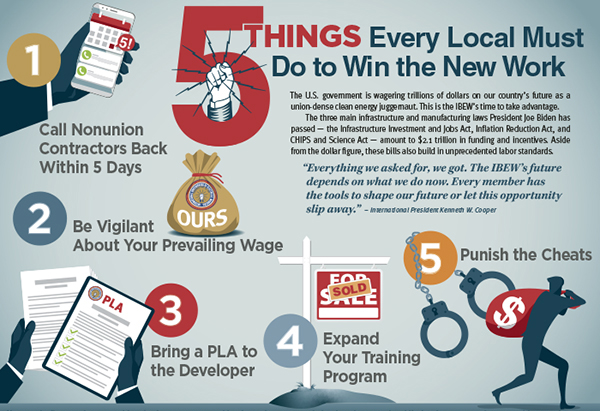
June 2023 |
|
|
 |
|
 Print Print
 Email EmailGo to www.ibew.org |
||
 |
||
Here are the five most important things business managers and locals can do now to maximize the gains we make while denying our nonunion competition any air to grow.
This one is the easiest, and that's why it is first. The IRA established tax credit programs that include a modest base credit for clean energy projects. If the developer pays the prevailing wage and hires registered apprentices, those tax credits may increase by as much as 400%. But a contractor or developer can get out from under these labor standards (and still get a bonus) if they request registered apprentices from our programs and we don't respond within five days. If a local union or training program doesn't call back — even to say no — the developer may qualify for the full bonus tax credit. "Do not blow people off," said Construction Department Director Matt Paules. "Call them back immediately. Tell them there is an easy way to get access to our apprentices: Sign up to the standard contract or a project labor agreement."
Nearly all of the $2.1 trillion is subject to prevailing wage. "If the rate in our collective bargaining agreements is the prevailing wage, our contractors have a tremendous advantage going into the bidding process," Paules said. But in almost half of U.S. counties, said Esmeralda Aguilar, a lawyer in the IBEW general counsel's office, our negotiated rates are not the prevailing wage. The only way our rates become the bid spec rates is if every business manager participates in the Department of Labor's prevailing wage survey and regularly updates the wage rate by submitting Form 654 through Local Connections. If a wage survey is coming up (looking at you, Texas, Arizona, New Hampshire and North Carolina), the Construction Department offers a training on how to participate. "If nonunion contractors set the prevailing wage because they responded to the wage survey and we didn't, all the political work we did is flushed down the toilet," said Government Affairs Director Danielle Eckert.
Manufacturing in the U.S. is set to boom in the next decade driven by the Buy American incentives in all three laws. We are already seeing new construction of colossal semiconductor campuses, and there will be billions more in new factory construction across the country. The CHIPS Act and IRA, developed with input from the IBEW and support from Biden, include a host of workforce development requirements, prevailing wage requirements and other important grant conditions for creating good jobs. By committing to use a PLA, a grant applicant can satisfy all of those requirements. Explaining this to a developer needs to happen at the earliest stages of a project's life, said Director of Business Development Ray Kasmark. "In your left hand you should have the workforce development requirements from the bill and in your right hand a PLA," he said. "You tell them, 'Every problem in my left hand is solved by what's in my right.'"
Crafting this legislation to benefit working people with union careers will not matter if we don't match the increase in work with an increase in market share. "We are like the dog that caught the car," Cooper said. "Now, whatever we were planning on doing before that bumper was in our mouth has got to change." He estimated that the IBEW will need at least 400,000 new "A" construction members in the next five to 10 years. That doesn't even account for needed growth in non-construction membership. Thanks to the new apprenticeship requirements and work opportunities in the IRA, our apprenticeship programs will be able to take in far more apprentices than ever before and significantly grow the workforce to meet demand. To find these new people, shake every tree in the forest and then find new forests. "Work with local high schools, not just community colleges but four-year college job fairs, community organizations, veterans' organizations to find workers who do not know about us but who are looking for the wages, benefits and job security we provide," said Government Affairs specialist Taylor Waites. "We're not going to reach 1 million members without targeting everyone." And if you think Cooper is talking about some other locals where work is already being let out to bid, he is not. "One million members isn't a nice benchmark. It's a life-or-death necessity," he said. "The JATC trustees need to buy those seven acres next to your JATC today and get started building tomorrow."
The good news is that all these federal dollars are chained to labor standards and high wages. The bad news is that an alliance of anti-union politicians and businesses is standing there with bolt cutters. Significant portions of the IIJA money flow from federal agencies to their state-level equivalents. Those state agencies are ultimately responsible for complying with the workforce development and labor standards. And all too often, they don't even pretend to try, Aguilar said. "We see it all the time: A state Department of Energy represents to a federal authority one thing, but then does exactly the opposite. They simply get a variance, like a doctor's note, and we call it a day," she said. Even when there is a labor-friendly administration in the White House, federal agencies might not armor up and fight to get that money back. Taking this fight into our own hands can't be done by business managers and locals alone. It is a duty we can do together, primarily through the state building trades councils. "There should be someone in each state, or a group of someones, tracking the contracts, tracking the program requirements and insisting the law is executed a s written," Cooper said. "It's our money. We cannot rely on anyone else to guard it." |
|
|
© Copyright 2023 International Brotherhood of Electrical Workers | User
Agreement and Privacy Policy |
Rights and Permissions |